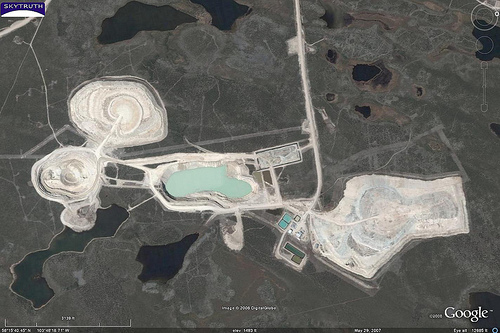Revelations last week that the northern Saskatchewan community of Pinehouse is set to sign a so-called “collaboration agreement” with uranium giants Cameco and Areva have sparked outrage in the community due to terms of the agreement that residents say is a blatant attempt to silence opposition to the expansion of uranium mining in the area.
A summary of the agreement, obtained by the Committee for Future Generations, contains a number of alarming terms, including that “Under the Collaboration Agreement, Pinehouse is expected to fully support Cameco/Areva’s mining,” including existing operations, proposed projects, and, incredibly, even future operations.
Perhaps most alarming, however, are the terms which aim to silence voices opposed to expanded uranium development. The two terms, contained under the section “Other Promises,” state that Pinehouse promises to “Not make statements or say things in public or to any government, business agency that opposes Cameco/Areva’s mining operations” and “Make reasonable efforts to ensure Pinehouse members do not say or do anything that interferes with or delays Cameco/Areva’s mining, or do or say anything that is not consistent with Pinehouse’s promises under the Collaboration Agreement.”
Despite these controversial terms, Gary Merasty, Cameco’s vice-president of corporate social responsibility, insists that the company “would never ask to gag anybody” and Pinehouse mayor Mike Natomagan defended the deal, saying, “We’re breaking new ground here.”
But Pinehouse residents aren’t convinced. In an interview with the Saskatoon StarPhoenix, Pinehouse resident John Smerek criticized the agreement, saying “I really don’t like this. I hope we can get it stopped. They are trying to take away our voice as individuals and as a community.”
The agreement, which includes a target date of December 31, 2012 but which some residents fear could be signed in the next two weeks, promises lump-sum payments to the Pinehouse Community trust when the agreement is signed, when production of the Cigar Lake mine begins, and when construction of the Millennium Mine begins, as well as promises of workforce and business development in the community.
The Cigar Lake mine, which could be the world’s largest uranium mine with proven and probable reserves of more than 216.7 million pounds of uranium, is scheduled for initial production in 2013. The Millennium mine project is currently in the approvals phase and is expected to begin initial engineering this year.
This expansion of the nuclear industry in Saskatchewan despite the vast majority of the province’s residents being opposed to more development. A public opinion survey (margin of error +/- 3.5 per cent, 19/20 times), conducted by Oraclepoll Research Ltd. in September 2012 and released by the Saskatchewan-based HUES3 Campaign (Heath, Uranium, Environment: Sustainability, Survival and Solidarity), found that more than two-thirds (68 per cent) of Saskatchewanians believe that no more uranium mines should be approved in the province until the huge mess of toxic radioactive tailings, which have been left behind over 60 years of mining activity, have been contained and cleaned up and that three-quarters (75 per cent) of the people in Saskatchewan don’t want radioactive waste brought into the province and deposited in underground storage. The poll also found that 45 per cent of people in Saskatchewan think plans to use nuclear reactors for oil sands extraction are totally unsafe.
The controversial agreement has already attracted national media attention, including an interview with Pinehouse Mayor Mike Natamagon on CBC’s As It Happens (at the 27 minute mark), an interview with Pinehouse residents Fred Pederson and John Smerek on CBC Saskatchwan’s Blue Sky program, responding to Cameco’s Gary Merasty’s interview on the show a day earlier.
For more on the collaboration agreement, and the community’s response, visit the Committee for Future Generations, the Coalition for a Clean Green Saskatchewan, and the HUE3 campaign’s Facebook page on the agreement. You can also read the Council of Canadians Saskatoon Chapter member Karen Rooney’s blog post on the issue, which she wrote from the COP18 conference in Qatar, which she is attending as part of the Canadian Youth Delegation.
Residents of Pinehouse, a largely Metis and First Nation community of just over 1000 residents located 400 km north of Saskatoon, are already fighting plans that could see the community becoming the site for the long-term storage of Canada’s nuclear waste. Pinehouse, as well as the northern Saskatchewan communities of Creighton and English River First Nation, are currently in the Nuclear Waste Management Organization’s (NWMO) site selection process to find a permanent repository for more than 2 million radioactive spent fuel rods.
Scott Harris is the Council of Canadians’ Prairies Regional Organizer.
Photo: SkyTruth/Flickr



